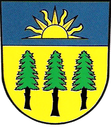Písečná u Jablunkova
| Písečná | ||||
|---|---|---|---|---|
|
||||
| Basic data | ||||
| State : |
|
|||
| Region : | Moravskoslezský kraj | |||
| District : | Frýdek-Místek | |||
| Area : | 236 ha | |||
| Geographic location : | 49 ° 34 ' N , 18 ° 47' E | |||
| Height: | 493 m nm | |||
| Residents : | 1.003 (Jan. 1, 2019) | |||
| Postal code : | 739 91 | |||
| License plate : | T | |||
| traffic | ||||
| Street: | Jablunkov - Písečná | |||
| structure | ||||
| Status: | local community | |||
| Districts: | 1 | |||
| administration | ||||
| Mayor : | David Ćmiel (as of 2008) | |||
| Address: | Písečná 42 739 91 Jablunkov |
|||
| Municipality number: | 557226 | |||
| Website : | www.obecpisecna.cz | |||
Písečná (German and Polish Pioseczna , 1939-1945: Pisetschna ) is a municipality in the Czech Republic . It is located two kilometers east of Jablunkov and belongs to the Okres Frýdek-Místek .
geography
Písečná is located on the right side of the Olsa at the foot of the Silesian Beskids in the Jablunkauer furrow. The village is located on the hill Na vrchu (519 m) in the valley of the Kotelnice brook. To the northeast rises the Kiczory (989 m), in the east the Ostrá hora (721 m).
Neighboring towns are Radvanov and Záhuří in the north, Bahenec and Bystrý in the east, Písek in the southeast, Folvark and Žihla in the south, Jablunkov in the west and Kostkov and Návsí in the northwest.
history
The first written mention of the place belonging to the town of Jablunkov took place in 1446, when the three Skřekov brothers from Jablunkov settled here. It is believed that the mountain settlement, like most of the other Wallachian Paseques around Jablunkov, was created at this time. After the large economy of the Skřekov family had been divided up over time, the Paseke became a village that had 64 residents around 1540. The settlers were mainly Wallachians ( Gorals ) from Jablunkov, who left the city to farm in the traditional way.
After the abolition of patrimonial Pioseczna formed from 1850 a district of Jablunkau in the Teschen district . In 1873 a school house was inaugurated. At the beginning of the 20th century, the Czech name Písečná began to be used. After the end of the First World War, the place belonged to Czechoslovakia. Because of the large Polish population, Poland also claimed the Olsa area and the Polish-Czechoslovak border war broke out . From 1920 the place belonged to the Český Těšín district. After the Munich Agreement , Pioseczna was annexed to Poland in 1938 and joined the German Reich the following year after the occupation of Poland. In 1939 the place name in Pisetschna was Germanized. Until 1945 Pisetschna belonged as a district of Jablunkau to the district of Teschen and came back to Czechoslovakia after the end of the war.
After the dissolution of the Okres Český Těšín, the place came to the Okres Frýdek-Místek at the beginning of 1961. Since January 1, 2001, Písečná has been an independent municipality for the first time in its history.
Community structure
No districts are shown for the municipality of Písečná. The settlement of Žihla belongs to Písečná.
Attractions
- Plenisko nature reserve on the summit of Kiczory in the Silesian Beskids, the protected area, which has existed since 1922, has had the status of a nature reserve since 1956. In 1998 it was expanded from 16.25 to 24.32 hectares.
- Chapel of the Black Madonna of Czenstochau, consecrated in 1926
- Chapel of St. Isidore
Individual evidence
- ↑ Český statistický úřad - The population of the Czech municipalities as of January 1, 2019 (PDF; 7.4 MiB)

